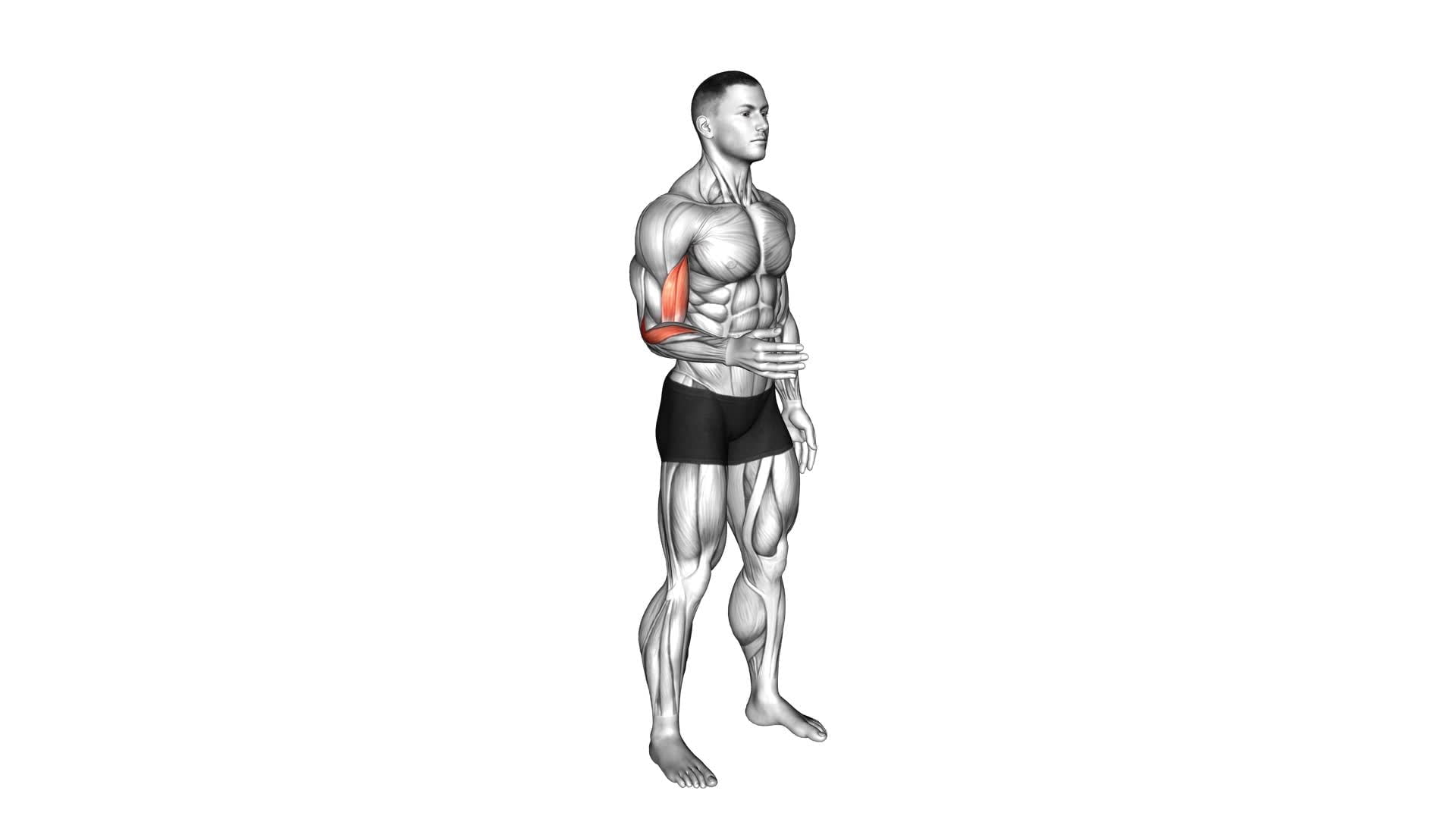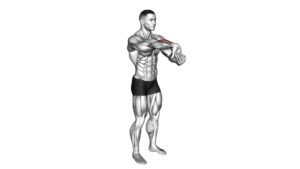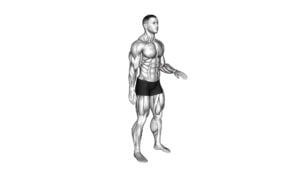Forearm – Supination – Video Exercise Guide & Tips

Looking to improve your forearm strength and flexibility? Check out our video exercise guide and tips for forearm supination.
Watch This Exercise Video
In this guide, you'll learn the benefits of forearm supination, proper form and technique, and find exercises suitable for all levels. Whether you're a beginner or advanced, our guide has got you covered.
So grab your equipment and get ready to take your forearm supination to the next level!
Key Takeaways
- Forearm supination exercises improve grip strength and prevent injuries.
- Proper form and technique, including maintaining neutral wrist position and engaging forearm muscles, are crucial for forearm supination exercises.
- Controlled and deliberate movements, along with proper wrist and hand alignment, should be followed to avoid mistakes.
- Beginner, intermediate, and advanced-level exercises can be performed for forearm supination, each offering different benefits and challenges.
Benefits of Forearm Supination
You can experience several benefits from incorporating forearm supination into your exercise routine. One of the key benefits is improved grip strength. By regularly performing forearm supination exercises, you can strengthen the muscles in your forearms that are responsible for gripping objects. This can be particularly beneficial for athletes, weightlifters, and anyone who relies on a strong grip in their daily activities.
In addition to improved grip strength, forearm supination exercises can also help prevent injuries. The muscles involved in forearm supination, such as the biceps and the supinator muscles, play a crucial role in stabilizing the wrist and forearm. Strengthening these muscles can provide better support and stability, reducing the risk of strains or sprains during physical activities.
By incorporating forearm supination exercises into your routine, you can't only enhance your grip strength but also reduce the chances of sustaining injuries. These benefits make forearm supination an essential component of any well-rounded exercise program.
Now that you understand the benefits, let's move on to the next section, where we'll discuss the proper form and technique for forearm supination.
Proper Form and Technique for Forearm Supination
To ensure proper form and technique for forearm supination, it's important to focus on correct wrist rotation and avoid common mistakes.
Maintaining a neutral wrist position and engaging the muscles of the forearm will help maximize the effectiveness of the exercise and minimize the risk of injury.
Correct Wrist Rotation
Achieve optimal forearm supination by mastering the correct wrist rotation technique. Proper wrist rotation is essential for maximizing the benefits of forearm supination exercises.
To improve your wrist mobility and enhance the strength of your forearms, incorporate specific strengthening exercises into your workout routine. These exercises include wrist curls, wrist rotations with dumbbells, and wrist flexion and extension exercises.
By regularly performing these exercises, you can increase the flexibility and range of motion in your wrists, allowing for better wrist rotation during forearm supination movements.
Remember to maintain proper form and technique throughout these exercises to avoid injury and achieve the best results.
With consistent practice and dedication, you can develop strong and mobile wrists, enhancing your forearm supination abilities.
Avoiding Common Mistakes
To ensure proper form and technique for forearm supination, it's crucial to avoid common mistakes that may hinder your progress. One common mistake to avoid is using excessive force or momentum while performing the exercise. This can lead to incorrect form and compromise the effectiveness of the movement. Instead, focus on using controlled and deliberate movements to isolate the muscles in your forearm.
Another mistake to avoid is neglecting proper wrist and hand alignment. Make sure to keep your wrist straight and your hand in a neutral position throughout the movement.
Additionally, be mindful of any discomfort or pain during the exercise. If you experience any discomfort, it's important to stop and consult with a professional to avoid potential injuries.
Essential Equipment for Forearm Supination Exercises
Using proper equipment is crucial for effectively performing forearm supination exercises. Here are some essential equipment options, variations, and modifications to consider:
- Dumbbells: Dumbbells are versatile and allow for a wide range of forearm supination exercises. Start with a weight that challenges you but still allows for proper form and gradually increase as you progress.
- Resistance Bands: Resistance bands provide a different type of resistance and can be used for both stretching and strengthening exercises. They're portable and can be easily adjusted to accommodate different levels of resistance.
- Wrist Rollers: Wrist rollers are a specialized piece of equipment designed specifically for forearm supination exercises. They consist of a handle and a weighted rope or bar that can be rolled up and down, targeting the muscles responsible for supination.
- Grip Strengtheners: Grip strengtheners, such as hand grippers or grip balls, can help improve overall grip strength, which is essential for forearm supination exercises. They come in various resistance levels, allowing you to gradually increase the challenge.
- Wrist Weights: Wrist weights can be worn during forearm supination exercises to add resistance and increase the intensity of the workout. They're available in different weight options, allowing you to customize the level of difficulty.
Remember to choose equipment that suits your fitness level and goals. It's always a good idea to consult with a fitness professional to ensure you're using the proper equipment and performing exercises correctly to avoid injury and get the most out of your workouts.
Beginner-Level Forearm Supination Exercises
Now let's talk about the benefits of incorporating forearm supination exercises into your workout routine.
Supination helps strengthen the muscles in your forearm, improving grip strength and wrist stability.
Benefits of Supination
Improve your forearm strength and flexibility with beginner-level forearm supination exercises. Supination, the movement of rotating your forearm to face up, offers several health benefits. Here are five reasons why incorporating supination exercises into your workout routine can be beneficial:
- Increased Grip Strength: Supination exercises target the muscles in your forearm, helping to improve your grip strength. This can be especially beneficial for athletes who rely on grip strength for their sport.
- Enhanced Wrist Stability: By strengthening the muscles involved in supination, you can improve the stability of your wrist joint, reducing the risk of injuries.
- Improved Range of Motion: Regularly performing supination exercises can help increase the range of motion in your forearm, allowing for better flexibility and movement.
- Injury Prevention: Strong forearms can help prevent common injuries, such as tendonitis and carpal tunnel syndrome.
- Functional Strength: Supination exercises mimic everyday movements, such as opening jars or turning doorknobs, improving your overall functional strength.
Incorporating beginner-level forearm supination exercises into your fitness routine can have numerous benefits for your overall forearm health and strength.
Proper Form Techniques
Mastering proper form techniques for beginner-level forearm supination exercises is crucial for maximizing the effectiveness of your workout.
One common mistake to avoid is using excessive wrist rotation during the exercise. It's important to focus on isolating the muscles in your forearm rather than relying on your wrist to perform the movement.
To ensure proper form, start by holding a dumbbell or any weighted object in your hand with your palm facing down. Slowly rotate your forearm while keeping your upper arm stationary.
As you rotate, make sure to engage the muscles in your forearm and maintain control throughout the movement.
Intermediate-Level Forearm Supination Exercises
To challenge your forearm muscles and build strength, incorporate intermediate-level forearm supination exercises into your workout routine. These exercises will help you progress and continue to improve your forearm supination abilities.
Here are five variations and progressions to try:
- Dumbbell Wrist Supination: Hold a dumbbell with an underhand grip and slowly rotate your wrist outward, keeping your elbow close to your side. Focus on controlling the movement and feeling the contraction in your forearm.
- Pronated to Supinated Forearm Twist: Start with your palms facing down and slowly rotate your forearms until your palms are facing up. Hold for a moment and then rotate back to the starting position. Repeat for the desired number of reps.
- Resistance Band Supination: Attach a resistance band to a stationary object and hold the other end with an underhand grip. Rotate your wrist outward against the resistance of the band, maintaining control throughout the movement.
- Barbell Reverse Curl: Hold a barbell with an overhand grip and slowly curl your hands upward, rotating your wrists so that your palms face up at the top of the movement. Lower the barbell back down with control.
- Supinated Forearm Plank: Assume a forearm plank position with your palms facing up. Engage your core and maintain a straight line from your head to your heels. Hold for the desired amount of time.
Incorporating these forearm supination exercises into your routine will help you develop strength and stability in your forearms, improving your overall athletic performance and reducing the risk of injury.
Advanced-Level Forearm Supination Exercises
Once you have mastered the intermediate-level forearm supination exercises, you can further challenge your forearm muscles with advanced-level variations. These advanced exercises won't only increase the strength and flexibility of your forearms but also provide a greater level of difficulty and intensity to your workout routine.
One advanced-level forearm supination variation is the weighted supination exercise. This exercise involves holding a dumbbell or a weighted object in your hand and slowly rotating your forearm to supinate it. This added resistance will engage your muscles even more and help you develop greater strength in your forearms.
Another advanced exercise is the pronation-supination combo. This exercise combines both pronation and supination movements, providing a comprehensive workout for your forearms. Start by holding a dumbbell in front of you with a pronated grip. Then, slowly rotate your forearm to supinate it and continue the movement until your palm is facing up. Reverse the movement back to the starting position and repeat.
It is important to note that advanced-level exercises require proper form and technique to prevent injuries. Common injuries in forearm supination exercises include strains, tendinitis, and overuse injuries. Therefore, it's crucial to warm up properly before attempting these exercises and to listen to your body to avoid overexertion.
If you experience any pain or discomfort, stop the exercise and consult with a healthcare professional.
Frequently Asked Questions
Is Forearm Supination Only Beneficial for Athletes or Can It Be Helpful for Everyday Individuals as Well?
Forearm supination isn't just for athletes; it can benefit everyday individuals as well. By incorporating proper technique into your forearm supination exercises, you can strengthen the muscles in your forearm, improve grip strength, and enhance overall functionality.
These exercises can be especially helpful for those who work with their hands or engage in activities that require forearm strength. So, don't underestimate the potential benefits of forearm supination, even if you're not an athlete.
Are There Any Common Mistakes to Avoid When Performing Forearm Supination Exercises?
When performing forearm supination exercises, it's important to be aware of common mistakes that can hinder your progress. These exercises offer benefits not only for athletes, but also for everyday individuals.
By avoiding mistakes like using excessive weight or improper form, you can maximize the effectiveness of your workout and reduce the risk of injury. Pay attention to your technique and start with lighter weights, gradually increasing as you become more comfortable.
Stay focused and enjoy the benefits of forearm supination exercises in your everyday life.
How Often Should Forearm Supination Exercises Be Incorporated Into a Workout Routine?
To get the most out of forearm supination exercises, it's important to know how often to incorporate them into your workout routine.
These exercises offer several benefits, such as improving grip strength and forearm muscle development.
To see results, it's recommended to perform forearm supination exercises two to three times per week. Start with two sets of 10-12 reps and gradually increase the intensity as your strength improves.
Remember to rest and recover between sessions for optimal muscle growth.
Can Forearm Supination Exercises Help With Conditions Such as Carpal Tunnel Syndrome or Tennis Elbow?
Forearm supination exercises are an effective way to improve grip strength. They can also provide relief for conditions like carpal tunnel syndrome and tennis elbow. Compared to other treatments, such as medication or surgery, forearm supination exercises offer a natural and non-invasive approach.
Are There Any Alternative Exercises or Variations That Can Be Done to Target the Same Muscles as Forearm Supination Exercises?
Looking for alternative exercises to target the same muscles as forearm supination exercises? You're in luck! There are several variations you can try.
Consider wrist curls or reverse curls, which also engage the muscles in your forearm.
Another option is using a resistance band to perform pronation exercises.
These alternatives can provide a similar level of muscle targeting as forearm supination exercises, giving you more options to diversify your workout routine.
Conclusion
In conclusion, forearm supination exercises offer numerous benefits, including improved grip strength and wrist mobility.
By following proper form and technique, utilizing essential equipment, and gradually progressing through beginner, intermediate, and advanced level exercises, individuals can effectively target and strengthen their forearm muscles.
Incorporating forearm supination exercises into a well-rounded fitness routine can contribute to overall upper body strength and functional movement.

Author
Years ago, the spark of my life’s passion ignited in my mind the moment I stepped into the local gym for the first time. The inaugural bead of perspiration, the initial endeavor, the very first surge of endorphins, and a sense of pride that washed over me post-workout marked the beginning of my deep-seated interest in strength sports, fitness, and sports nutrition. This very curiosity blossomed rapidly into a profound fascination, propelling me to earn a Master’s degree in Physical Education from the Academy of Physical Education in Krakow, followed by a Sports Manager diploma from the Jagiellonian University. My journey of growth led me to gain more specialized qualifications, such as being a certified personal trainer with a focus on sports dietetics, a lifeguard, and an instructor for wellness and corrective gymnastics. Theoretical knowledge paired seamlessly with practical experience, reinforcing my belief that the transformation of individuals under my guidance was also a reflection of my personal growth. This belief holds true even today. Each day, I strive to push the boundaries and explore new realms. These realms gently elevate me to greater heights. The unique combination of passion for my field and the continuous quest for growth fuels my drive to break new ground.







